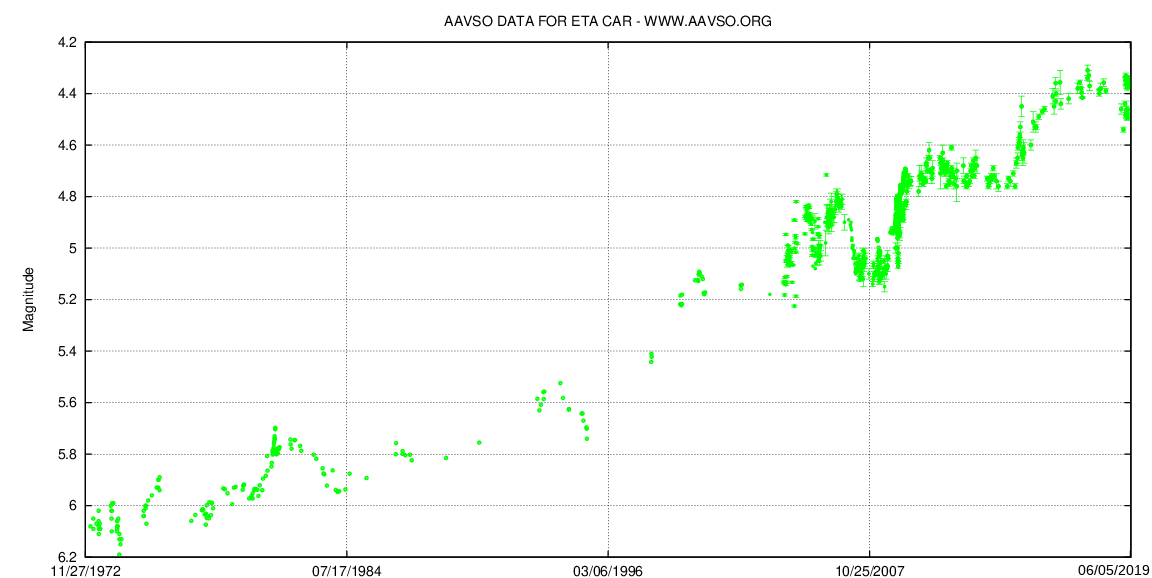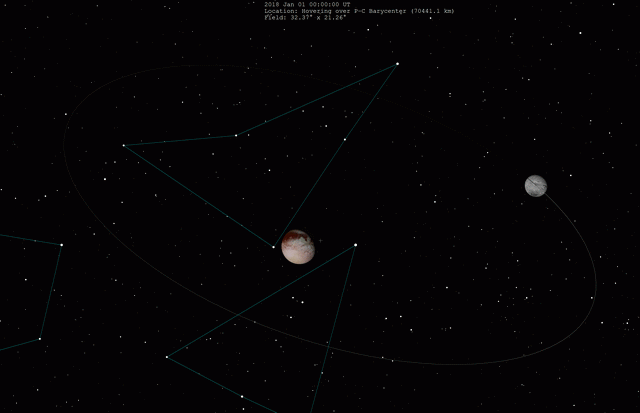|
╬Ę Carinae
╬Ę Carinae (Eta Carinae, abbreviated to ╬Ę Car), formerly known as ╬Ę Argus, is a stellar system containing at least two stars with a combined luminosity greater than five million times that of the Sun, located around distant in the constellation Carina. Previously a 4th-magnitude star, it brightened in 1837 to become brighter than Rigel, marking the start of its so-called "Great Eruption". It became the second-brightest star in the sky between 11ŌĆō14 March 1843 before fading well below naked-eye visibility after 1856. In a smaller eruption, it reached 6th magnitude in 1892 before fading again. It has brightened consistently since about 1940, becoming brighter than magnitude 4.5 by 2014. At declination ŌłÆ59┬░ 41ŌĆ▓ 04.26ŌĆ│, ╬Ę Carinae is circumpolar from locations on Earth south of latitude 30┬░S (for reference, the latitude of Johannesburg is 26┬░12ŌĆ▓S), and is not visible north of about latitude 30┬░N, just south of Cairo (whic ... [...More Info...] [...Related Items...] OR: [Wikipedia] [Google] [Baidu] |
Eta Carinae
╬Ę Carinae (Eta Carinae, abbreviated to ╬Ę Car), formerly known as ╬Ę Argus, is a stellar system containing at least two stars with a combined luminosity greater than five million times that of the Sun, located around distant in the constellation Carina. Previously a 4th-magnitude star, it brightened in 1837 to become brighter than Rigel, marking the start of its so-called "Great Eruption". It became the second-brightest star in the sky between 11ŌĆō14 March 1843 before fading well below naked-eye visibility after 1856. In a smaller eruption, it reached 6th magnitude in 1892 before fading again. It has brightened consistently since about 1940, becoming brighter than magnitude 4.5 by 2014. At declination ŌłÆ59┬░ 41ŌĆ▓ 04.26ŌĆ│, ╬Ę Carinae is circumpolar from locations on Earth south of latitude 30┬░S (for reference, the latitude of Johannesburg is 26┬░12ŌĆ▓S), and is not visible north of about latitude 30┬░N, just south of Cairo (w ... [...More Info...] [...Related Items...] OR: [Wikipedia] [Google] [Baidu] |
Henry Draper Catalogue
The ''Henry Draper Catalogue'' (HD) is an astronomical star catalogue published between 1918 and 1924, giving spectroscopic classifications for 225,300 stars; it was later expanded by the ''Henry Draper Extension'' (HDE), published between 1925 and 1936, which gave classifications for 46,850 more stars, and by the ''Henry Draper Extension Charts'' (HDEC), published from 1937 to 1949 in the form of charts, which gave classifications for 86,933 more stars. In all, 359,083 stars were classified as of August 2017. The HD catalogue is named after Henry Draper, an amateur astronomer, and covers the entire sky almost completely down to an apparent photographic magnitude of about 9; the extensions added fainter stars in certain areas of the sky. The construction of the ''Henry Draper Catalogue'' was part of a pioneering effort to classify stellar spectra, and its catalogue numbers are commonly used as a way of identifying stars. History The origin of the ''Henry Draper Catalogue'' d ... [...More Info...] [...Related Items...] OR: [Wikipedia] [Google] [Baidu] |
Circumpolar Star
A circumpolar star is a star that, as viewed from a given latitude on Earth, never sets below the horizon due to its apparent proximity to one of the celestial poles. Circumpolar stars are therefore visible from said location toward the nearest pole for the entire night on every night of the year (and would be continuously visible throughout the day too, were they not overwhelmed by the Sun's glare). Others are called ''seasonal'' stars. All circumpolar stars lie within a circumpolar circle whose size is determined by the observer's latitude. Specifically, the angular measure of the radius of this circle equals the observer's latitude. The closer the observer is to the North or South Pole, the larger its circumpolar circle. Before the definition of the Arctic was formalized as the region north of the Arctic Circle which experiences the midnight sun, it more broadly meant those places where the 'bear' constellations (Ursa Major, the Great Bear, and Ursa Minor, the Little Bear) we ... [...More Info...] [...Related Items...] OR: [Wikipedia] [Google] [Baidu] |
Naked-eye
Naked eye, also called bare eye or unaided eye, is the practice of engaging in visual perception unaided by a magnifying, light-collecting optical instrument, such as a telescope or microscope, or eye protection. In astronomy, the naked eye may be used to observe celestial events and objects visible without equipment, such as conjunctions, passing comets, meteor showers, and the brightest asteroids, including 4 Vesta. Sky lore and various tests demonstrate an impressive variety of phenomena visible to the unaided eye. Basic properties Some basic properties of the human eye are: *Quick autofocus from distances of 25 cm (young people) to 50 cm (most people 50 years and older) to infinity. *Angular resolution: about 1 arcminute, approximately 0.017┬░ or 0.0003 radians, which corresponds to 0.3 m at a 1 km distance. *Field of view (FOV): simultaneous visual perception in an area of about 160┬░ ├Ś 175┬░. *Ability to see faint stars up to +8 magnitude unde ... [...More Info...] [...Related Items...] OR: [Wikipedia] [Google] [Baidu] |
List Of Brightest Stars
This is a list of stars arranged by their apparent magnitude ŌĆō their brightness as observed from Earth. It includes all stars brighter than magnitude +2.50 in visible light, measured using a ''V''-band filter in the UBV photometric system. Stars in binary systems (or other multiples) are listed by their ''total'' or ''combined'' brightness if they appear as a single star to the naked eye, or listed separately if they do not. As with all magnitude systems in astronomy, the scale is logarithmic and inverted i.e. lower/more negative numbers are brighter. Most stars on this list appear bright from Earth because they are nearby, not because they are intrinsically luminous. For a list which compensates for the distances, converting the ''apparent'' magnitude to the ''absolute'' magnitude, see the list of most luminous stars. Measurement The Sun is the brightest star as viewed from Earth, at −26.78 mag. The second brightest is Sirius at −1.46 mag. Fo ... [...More Info...] [...Related Items...] OR: [Wikipedia] [Google] [Baidu] |
Rigel
Rigel is a blue supergiant star in the constellation of Orion. It has the Bayer designation ╬▓ Orionis, which is Latinized to Beta Orionis and abbreviated Beta Ori or ╬▓ Ori. Rigel is the brightest and most massive componentand the eponymof a star system of at least four stars that appear as a single blue-white point of light to the naked eye. This system is located at a distance of approximately . A star of spectral type B8Ia, Rigel is calculated to be anywhere from 61,500 to 363,000 times as luminous as the Sun, and 18 to 24 times as massive, depending on the method and assumptions used. Its radius is more than seventy times that of the Sun, and its surface temperature is . Due to its stellar wind, Rigel's mass-loss is estimated to be ten million times that of the Sun. With an estimated age of seven to nine million years, Rigel has exhausted its core hydrogen fuel, expanded, and cooled to become a supergiant. It is expected to end its life as a typeII su ... [...More Info...] [...Related Items...] OR: [Wikipedia] [Google] [Baidu] |
Apparent Magnitude
Apparent magnitude () is a measure of the Irradiance, brightness of a star, astronomical object or other celestial objects like artificial satellites. Its value depends on its intrinsic luminosity, its distance, and any extinction (astronomy), extinction of the object's light caused by interstellar dust along the sightline, line of sight to the observer. Unless stated otherwise, the word ''magnitude'' in astronomy usually refers to a celestial object's apparent magnitude. The magnitude scale likely dates to before the ancient Ancient Greek astronomy#Astronomy in the Greco-Roman and Late Antique eras, Roman astronomer Ptolemy, Claudius Ptolemy, whose Star catalogue, star catalog popularized the system by listing stars from First-magnitude star, 1st magnitude (brightest) to 6th magnitude (dimmest). The modern scale was mathematically defined to closely match this historical system by Norman Robert Pogson, Norman Pogson in 1856. The scale is reverse logarithmic scale, logarithmic: ... [...More Info...] [...Related Items...] OR: [Wikipedia] [Google] [Baidu] |
Constellation
A constellation is an area on the celestial sphere in which a group of visible stars forms Asterism (astronomy), a perceived pattern or outline, typically representing an animal, mythological subject, or inanimate object. The first constellations were likely defined in prehistory. People used them to relate stories of their beliefs, experiences, creation myth, creation, and mythology. Different cultures and countries invented their own constellations, some of which lasted into the early 20th century before today's constellations were internationally recognized. The recognition of constellations has changed significantly over time. Many changed in size or shape. Some became popular, only to drop into obscurity. Some were limited to a single culture or nation. Naming constellations also helped astronomers and navigators identify stars more easily. Twelve (or thirteen) ancient constellations belong to the zodiac (straddling the ecliptic, which the Sun, Moon, and planets all traver ... [...More Info...] [...Related Items...] OR: [Wikipedia] [Google] [Baidu] |
Luminosity
Luminosity is an absolute measure of radiated electromagnetic radiation, electromagnetic energy per unit time, and is synonymous with the radiant power emitted by a light-emitting object. In astronomy, luminosity is the total amount of electromagnetic energy emitted per unit of time by a star, galaxy, or other astronomical object, astronomical objects. In SI units, luminosity is measured in joules per second, or watts. In astronomy, values for luminosity are often given in the terms of the Solar luminosity, luminosity of the Sun, ''L''ŌŖÖ. Luminosity can also be given in terms of the astronomical Magnitude (astronomy), magnitude system: the Absolute magnitude#Bolometric magnitude, absolute bolometric magnitude (''M''bol) of an object is a logarithmic measure of its total energy emission rate, while absolute magnitude is a logarithmic measure of the luminosity within some specific wavelength range or Passband, filter band. In contrast, the term ''brightness'' in astronomy is gene ... [...More Info...] [...Related Items...] OR: [Wikipedia] [Google] [Baidu] |
Binary System
A binary system is a system of two astronomical bodies of the same kind that are comparable in size. Definitions vary, but typically require the center of mass to be located outside of either object. (See animated examples.) The most common kinds of binary system are binary stars and binary asteroids, but brown dwarfs, planets, neutron stars, black holes and galaxies can also form binaries. A ''multiple system'' is similar but consists of three or more objects, for example triple stars and triple asteroids (a more common term than 'trinary'). Classification In a binary system, the brighter or more massive object is referred to as primary, and the other the secondary. Binary stars are also classified based on orbit. Wide binaries are objects with orbits that keep them apart from one another. They evolve separately and have very little effect on each other. Close binaries are close to each other and are able to transfer mass from one another. They can also be classified ba ... [...More Info...] [...Related Items...] OR: [Wikipedia] [Google] [Baidu] |
Stellar System
A star system or stellar system is a small number of stars that orbit each other, bound by gravitational attraction. It may sometimes be used to refer to a single star. A large group of stars bound by gravitation is generally called a ''star cluster'' or ''galaxy'', although, broadly speaking, they are also star systems. Star systems are not to be confused with planetary systems, which include planets and similar bodies (such as comets). Terminology A star system of two stars is known as a ''binary star'', ''binary star system'' or ''physical double star''. Systems with four or more components are rare, and are much less commonly found than those with 2 or 3. Multiple-star systems are called ''triple'', ''ternary'', or ''trinary'' if they contain three stars; ''quadruple'' or ''quaternary'' if they contain four stars; ''quintuple'' or ''quintenary'' with five stars; ''sextuple'' or ''sextenary'' with six stars; ''septuple'' or ''septenary'' with seven stars; and ''octuple' ... [...More Info...] [...Related Items...] OR: [Wikipedia] [Google] [Baidu] |
AAVSO
The American Association of Variable Star Observers (AAVSO) is an international nonprofit organization. Founded in 1911, the organization focuses on coordinating, analyzing, publishing, and archiving variable star observations made largely by amateur astronomers. The AAVSO creates records that establish light curves depicting the variation in brightness of a star over time. The AAVSO makes these records available to professional astronomers, researchers, and educators. Professional astronomers do not have the resources to monitor every variable star. Hence, astronomy is one of the few sciences where amateurs can make significant contributions to research. In 2011, the 100th year of the AAVSO's existence, the twenty-millionth variable star observation was received into their database. The AAVSO International Database (AID) has stored over thirty-five million observations as of 2019. The organization receives nearly 1,000,000 observations annually from an estimated amount of 2,000 ... [...More Info...] [...Related Items...] OR: [Wikipedia] [Google] [Baidu] |










